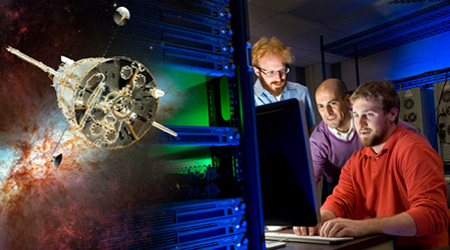The Troya Group

Research Interests:
We develop research in various topics of physical chemistry. Our fields of expertise are quantum-mechanical calculations and molecular dynamics simulations. These techniques are used to investigate a wide variety of physical and chemical phenomena, ranging from erosion of polymers that coat spacecraft and satellites in low-Earth orbit to fracture of carbon nanotubes.
Erosion of Polymers in Low-Earth Orbit:
The harsh environment encountered by spacecraft operating in low-Earth orbit (LEO) causes degradation of the polymers that are used to coat their surfaces. The composition of the LEO atmosphere (200-700 km altitude) indicates that ground-state atomic oxygen (O(3P)) is the dominant species. The number densities of other species such as molecular oxygen, argon or molecular nitrogen are also significant. The reactivity of such chemical species of the LEO atmosphere is enhanced by the very large velocity of their impacts with the spacecraft surfaces. A spacecraft in LEO travels at about 8 km/s (the International Space Station or the Hubble telescope give a complete turn around the Earth in ~90 min). This gives rise to collisions of the spacecraft with the gases forming the LEO atmosphere at energies more than two orders of magnitude larger than the average energy at room temperature. This energy regime is known as ‘hyperthermal’. Ground-based experiments on erosion of polymers in LEO are very difficult and costly. This provides an excellent opportunity for the development of computational studies that will unveil aspects of polymer degradation processes and will complement in-flight and ground-based experiments. We carry out simulations of hyperthermal collisions of gas-phase chemical species with polymers analogous to those used as thermal blankets and protective paints of spacecraft in LEO. Collision processes are simulated using classical trajectories (a widely-used molecular dynamics technique). Quantum chemistry is used to describe the interaction potential acting between the hyperthermal projectiles and the polymers.
Mechanical Properties of Carbon Nanotubes:
Carbon nanotubes (CNTs) are exceptional materials that are attracting the attention of a large number of interdisciplinary research teams due to their superior electronic, optical, thermal and mechanical properties. CNTs are the strongest materials known. By weight, they are two orders of magnitude stronger than reinforced steel. However, they are six times less heavy than steel. Their extraordinary strength and lightweight nature make them perfect candidates to act as reinforcement fibers in conventional polymeric matrices. Our research is focused on mechanical properties of CNTs. Quantum-mechanical calculations using semiempirical Hamiltonians, wave function ab initio-based techniques, and density functional theory are carried out using high-capacity computing facilities at Virginia Tech to study various mechanical properties ranging from stiffness to strength and fracture. In particular, one of the main goals is to understand the influence of defects in the mechanical properties of CNTs. These defects are commonly introduced in current synthetic routes, and include Stone-Wales bond rotations, vacancy defects, doping and covalent coordination of chemical species to the side-wall of the CNTs.
Visit our group website to learn more: The Troya Group